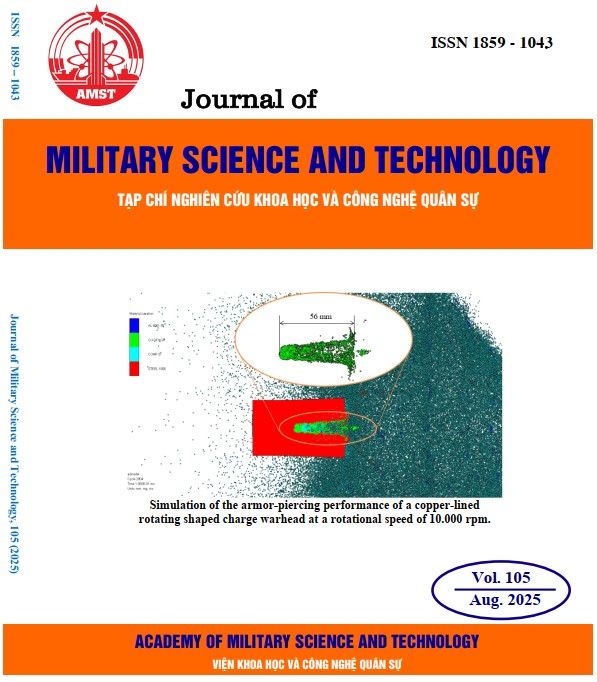Ảnh hưởng của một số yếu tố tới quá trình điện phân chế tạo natri perchrorate từ natri chlorat sử dụng điện cực PbO2/Pb-Ti
480 lượt xemDOI:
https://doi.org/10.54939/1859-1043.j.mst.105.2025.90-97Từ khóa:
Natri perchlorate; Điện phân; Natri chrorate; Điện cực PbO2.Tóm tắt
Quá trình điện phân chế tạo natri perchlorate từ natri chlorate sử dụng điện cực PbO2/Pb-Ti đã được nghiên cứu bằng phương pháp quét thế tuyến tính (LSV), phổ tổng trở điện hóa (EIS) và đánh giá hiệu suất điện phân. Kết quả cho thấy các thông số công nghệ (nồng độ natri chlorate, nhiệt độ, mật độ dòng điện phân, hàm lượng phụ gia và pH) ảnh hưởng mạnh đến sự phân cực, điện trở chuyển điện tích và hiệu suất điện phân. Từ đó, chế độ công nghệ thích hợp cho quá trình điện phân được lựa chọn là: nồng độ NaClO3 300 – 600 g/L; nhiệt độ 50 oC; mật độ dòng điện 0,15 - 0,2 A/cm3; nồng độ phụ gia NaF 1-2 g/L; pH dung dịch 7.
Tài liệu tham khảo
[1]. T. Chongcheng, Y. Pei, “Method for producing sodium perchlorate”, Patent CN 1012742B, (1991).
[2]. Henry C. Miller, John C Grigger, “Method of producing perchlorates”, Patent US2813825A, (1957).
[3]. Javier Llanos et al., “Electrochemical production of perchlorate as an alternative for the valorization of brines”, Chemosphere, Vol. 220, pp. 637-643 (2019). DOI: https://doi.org/10.1016/j.chemosphere.2018.12.153
[4]. Ahmed D. Wiheeb, “The manufacture of perchlorate by direct method using graphite substrate lead dioxide (Gsld) anode”, Diyala Journal of Engineering Sciences, Vol. 2(1), pp. 66-79 (2009). DOI: https://doi.org/10.24237/djes.2009.01105
[5]. Jean-Christophe Millet, Michel Jaccaud, “Continuous electrolytic production of alkal metal perchlorates”, Patent US 5004527, (1991).
[6]. Handady V. K. Udupa et al., “Electrolytic preparation of perchlorate”, Patent US3493478, (1970).
[7]. M. Cheraghveisi et al., ”Electrosynthesis of perchlorate using neodymium-doped PbO2 electrode: application of experimental design methodology for optimization of the effective parameters”, Materials Research Express, Vol. 9(2), pp. 1-10 (2022). DOI: https://doi.org/10.1088/2053-1591/ac5551
[8]. Sai Bhavaraju, James Steppan, “Bismuth metal oxide pyrochlores as electrode materials”, Patent EP 2443269A2, (2012).
[9]. A. Sánchez-Carretero et al., “Electrochemical production of perchlorates using conductive diamond electrolyses”, Chemical Engineering Journal, Vol. 166(2), pp. 710-714, (2011). DOI: https://doi.org/10.1016/j.cej.2010.11.037
[10]. L. J. J. Janssen, P. D. L. Van Der Heyden, “Mechanism of anodic oxidation of chlorate to perchlorate on platinum electrodes, Journal of Applied Electrochemistry”, Vol. 25 (2), pp. 126 – 136, (1995). DOI: https://doi.org/10.1007/BF00248169
[11]. Takashi Osuga, Shojiro Fujii, Kiichiro Sugino, Taro Sekine, “Electrolytic production of perchlorate by lead dioxide anodes”, Journal of The Electrochemical Society, Vol. 116 (2), pp. 203 -207, (1969). DOI: https://doi.org/10.1149/1.2411796
[12]. Joseph C. Schumacher et al., “Electrolytic production of Sodium perchlorate using Lead dioxide anodes”, Journal of The Electrochemical Society, Vol. 105 (3), pp. 151, (1958). DOI: https://doi.org/10.1149/1.2428781
[13]. Rossano Amadelli, A. B. Velichenko, “Lead dioxide electrodes for high potential anodic processes”, Journal of the Serbian Chemical Society, Vol. 66 (11-12), pp. 835-845 (2001). DOI: https://doi.org/10.2298/JSC0112835A
[14]. M. Munichandraiah et al., “Kinetics and mechanism of anodic oxidation of chlorate ion to perchlorate ion on lead dioxide electrodes”, Journal of Applied Electrochemistry, Vol. 17, pp. 33-48, (1987). DOI: https://doi.org/10.1007/BF01009129
[15]. Z. Chen et al., “A novel Pb/PbO2 electrodes prepared by the method of thermal oxidation-electrochemical oxidation: Characteristic and electrocatalytic oxidation performance”, Journal of Alloys and Compounds, Vol. 851, pp. 156834, (2021). DOI: https://doi.org/10.1016/j.jallcom.2020.156834







